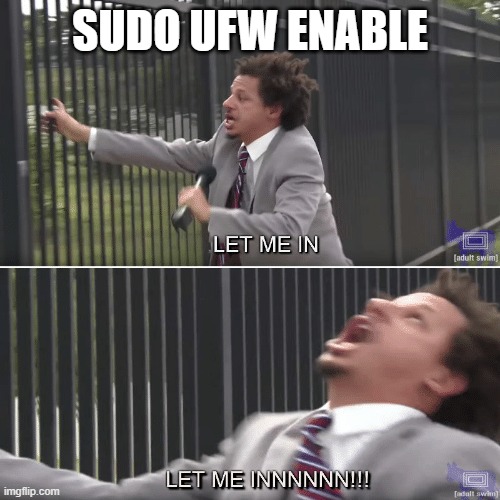UFW: Accidentally locked out SSH Port (22)
Introduction¶
So, you've just launched your first AWS EC2 instance. Awesome! But wait, what’s that? Your instance is up, but you can’t seem to connect? You might have stumbled into a common issue that many newbies face: Firewall Configuration
AWS offers security groups by default, but sometimes, you'll want more control using tools like UFW (Uncomplicated Firewall), This article will guide you through solving firewall problems using UFW on your EC2 instance and avoid locking yourself out.
Understanding UFW and AWS Security Groups¶
What is UFW?¶
UFW stands for "Uncomplicated Firewall." As the name suggests, it’s designed to simplify the process of managing iptables rules, which can be quite complex. UFW helps you quickly allow or block traffic on specific ports with simple commands.
What are AWS Security Groups?¶
AWS Security Groups are virtual firewalls provided by AWS to control traffic to and from your EC2 instances. They are essential for managing inbound and outbound rules at a higher, network-based level.
Why Configuring UFW on EC2 Causes Issues?¶
Beginners often face problems because they forget that AWS Security Groups and UFW can sometimes overlap in functionality. If you configure UFW without considering your security group rules, you might block traffic that was previously allowed, leading to issues like getting locked out of your instance.
Tip
I do recommend only use AWS Security Group and leave UFW configuration open all port
If you want to control which port opened, just use AWS Security Group from AWS Console or AWS CLI 😁
Resolution¶
You could use the following Simplest way (user-data) to turn off the ufw.
- Access your AWS EC2 Instance
- Stop the instance first
- In Instance Settings, View/Change User Data
-
Copy and Set the below user data as plain text and save
Content-Type: multipart/mixed; boundary="//" MIME-Version: 1.0 --// Content-Type: text/cloud-config; charset="us-ascii" MIME-Version: 1.0 Content-Transfer-Encoding: 7bit Content-Disposition: attachment; filename="cloud-config.txt" #cloud-config cloud_final_modules: - [scripts-user, once] --// Content-Type: text/x-shellscript; charset="us-ascii" MIME-Version: 1.0 Content-Transfer-Encoding: 7bit Content-Disposition: attachment; filename="userdata.txt" #!/bin/bash sudo ufw disable --// -
Start AWS EC2 Instance
-
Remove UFW Rules and Disable UFW by default
-
Remove User Data from EC2 Instance (optional)
Testing Your Configuration¶
Once you've set everything up, you can test your firewall by trying to access your EC2 instance from different IP addresses or running network diagnostic tools.
Conclusion¶
Configuring UFW for your AWS EC2 instance can be tricky for beginners, but with careful planning and understanding of how UFW and AWS Security Groups interact, you can create a secure environment for your applications. Don’t rush the process — take your time to set up, test, and refine your firewall settings.

